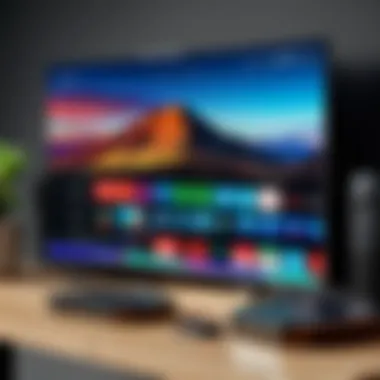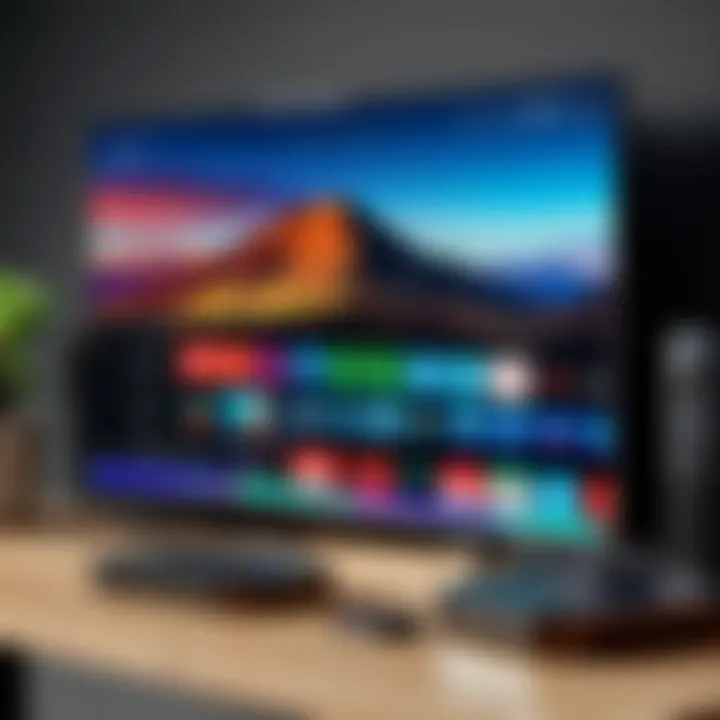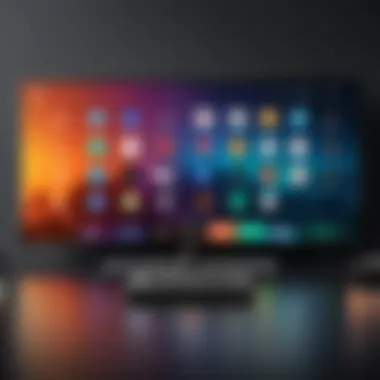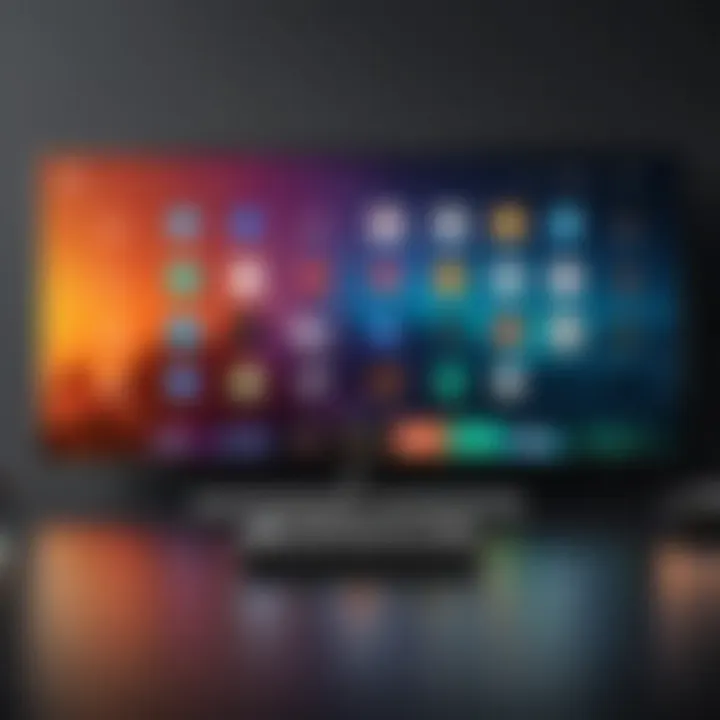Screen Mirroring Android Devices to Firestick


Intro
Screen mirroring has evolved as a vital feature for many tech-savvy individuals. This capability enables users to share content from their Android devices directly onto larger screens, such as those connected to an Amazon Firestick. As streaming and content consumption have become integral parts of daily life, understanding this technology becomes increasingly relevant.
By utilizing screen mirroring, users can enhance their viewing experience, turning their mobile devices into controllers or showcasing their favorite apps, photos, and videos on a bigger screen. This article aims to provide a comprehensive guide to mastering screen mirroring between Android devices and Amazon Firestick. You will learn about the technologies involved, practical steps to enable the feature, and possible troubleshooting methods for when things do not go as planned.
Through a detailed discussion, readers will gain insights into the advantages of screen mirroring and explore how this technique compares to other streaming options. The goal is to equip you with the knowledge and skills necessary to leverage this feature effectively, ultimately enriching your media consumption experience.
Foreword to Screen Mirroring
Screen mirroring has transcended from a niche requirement to a widely used feature, especially among tech-savvy individuals. In this digital age, where content consumption is often done on larger displays, the relevance of screen mirroring becomes clear. It enables users to project the content of their Android devices onto a Firestick, facilitating an enhanced media experience. This method not only unifies the viewing habits of users but also eliminates the need for multiple devices, thus streamlining entertainment.
Definition of Screen Mirroring
Screen mirroring refers to the process of displaying the screen of one device on another in real-time. In this context, it primarily involves transmitting the screen of an Android device to an Amazon Firestick. The transmission often happens over a wireless network, making it convenient for users who wish to view apps, videos, or photos on a larger screen without needing to connect any cables. Essentially, it replicates what is on the mobile device's screen onto the TV, allowing for a more enjoyable experience.
Overview of Firestick Capabilities
The Amazon Firestick is a versatile streaming device that supports a range of functionalities. It not only allows access to popular streaming platforms like Netflix and Amazon Prime Video but also serves as a hub for many applications. Its compatibility with various devices enhances its usability. Firestick offers various capabilities such as voice control, streaming in 4K resolution, and support for a family of Fire apps. Moreover, its ability to connect to different mobile devices for screen mirroring makes it a powerful tool for enhancing the overall media experience.
Screen mirroring with Firestick provides a seamless transition between devices, making it easier for users to enjoy their content. You can share presentations, play games, or even display your favorite photos from your Android device to a bigger screen.
"Screen mirroring enhances the interactive experience by bridging the content from personal devices to larger displays."
With understanding screen mirroring and the capabilities of Firestick, users can unlock potential for optimized media consumption in their day-to-day lives.
Understanding the Firestick
The Amazon Firestick serves as a bridge between traditional television viewing and modern streaming habits. Understanding the Firestick is crucial in the context of screen mirroring. This section provides insights into the device's capabilities and encourages efficient integration with Android devices. Knowing the key features and types of Firestick devices can greatly enhance one's media consumption experience. It ensures that users maximize the potential of their devices, resulting in smoother performance and better versatility.
Features of Firestick
The Amazon Firestick is packed with several powerful features that cater to both casual viewers and tech enthusiasts. Some key features include:
- Streaming Abilities: The Firestick supports various streaming services, including Prime Video, Netflix, Hulu, and many more.
- Voice Control: With Alexa built-in, users can control the Firestick through voice commands, enhancing user experience.
- 3rd Party App Support: Users can download apps from the Amazon Appstore, allowing for a customizable viewing experience.
- User-Friendly Interface: The simple and intuitive interface makes navigation straightforward, even for users who are not tech-savvy.
- Regular Updates: Amazon consistently provides updates to improve functionality and security, keeping the device relevant.
These features make the Firestick a versatile device for streaming and enhance its suitability for screen mirroring.
Types of Firestick Devices
There are several types of Firestick devices available, each designed to meet different user needs. Understanding these options is valuable when selecting the right device for screen mirroring. The main types include:
- Fire TV Stick: This is the basic model, ideal for most streaming needs. It supports up to 1080p resolution and audio formats.
- Fire TV Stick 4K: Offers enhanced resolution up to 4K, and supports HDR for a superior visual experience. This model is ideal for those who want to maximize their video quality.
- Fire TV Stick Lite: A cheaper alternative that includes essential features but lacks voice control capability. This option might appeal to users looking for basic functionality.
- Fire TV Cube: Combines the capability of a Firestick with the features of a smart speaker. Its hands-free operation adds convenience.
Understanding these types allows users to make informed decisions based on their specific requirements, optimizing the screen mirroring experience.
Basics of Android Screen Mirroring
Screen mirroring has become a significant feature for many users, especially with the prevalence of streaming devices like Amazon Firestick. This section aims to explore the basics of Android screen mirroring, emphasizing its importance and the advantages it provides.
Screen mirroring essentially allows users to share their device’s display with an external screen. With the rise in the consumption of digital content, this functionality proves essential for enhancing the viewing experience. By utilizing screen mirroring to connect your Android device to the Firestick, you can enjoy videos, games, and apps on a much larger screen. This experience can transform a mundane activity like watching a video into an engaging visual feast, leading to a more enjoyable time with friends and family.
Here are a few key points regarding basics of Android screen mirroring:
- Increased screen size for better visibility.
- Simplified sharing of content in social settings.
- Enhanced gaming experiences on bigger displays.
- Potential for seamless presentations in professional settings.


Despite its advantages, users must also consider certain limitations when using screen mirroring. Compatibility might vary based on the device model or the version of the software running on Android. Therefore, knowing the technical requirements is crucial for effective usage.
Compatibility with Firestick
Understanding compatibility is essential for seamless mirroring. The Firestick is designed to work with a range of devices, but not all Android devices support direct mirroring features. To ensure a successful connection, users should check if their Android device supports Miracast, which is widely used for screen mirroring. If your Android device does support this protocol, you can connect effortlessly to your Firestick.
You can do a quick check in your device's settings, typically under
- Display Settings
- Wireless Display If these options are available, it's likely your device supports screen mirroring.
Supported Android Versions
Not all Android versions are equal when it comes to screen mirroring functionalities. Versions from Android 4.2 (Jelly Bean) and above generally have some built-in screen mirroring capabilities. However, the experience may vary significantly based on different manufacturers' implementations. For instance, while Google Pixel devices might provide a robust screen mirroring experience, some budget brands may offer limited or no support at all.
It is advisable to keep your Android device updated. Regular updates not only improve performance but may also include enhancements for screen casting functionalities. Additionally, being aware of the latest Android version can help ensure maximum compatibility with Firestick.
Methods to Mirror Android to Firestick
Screen mirroring Android devices to Amazon Firestick is a fundamental aspect of enhancing the multimedia experience. This section outlines different methods available to accomplish this task and highlights their relevance. Each method serves a unique purpose, offering varying degrees of flexibility and convenience.
Understanding these methods not only aids in choosing the right approach but also maximizes the potential of your connected devices.
Using Built-in Features
Firestick provides built-in options for screen mirroring. This is convenient as it eliminates the need for additional apps. To use built-in features, users must first ensure that their Android device supports Miracast, a common protocol for screen mirroring.
To activate this built-in option on Firestick, go to Settings, then Display & Sounds, and select Enable Display Mirroring. Once activated, the Firestick will be discoverable for device connections.
On your Android device, navigate to Settings > Connected Devices > Connection Preferences > Cast. Ensure the Firestick is selected as the destination. The seamless integration of built-in features is noteworthy as it provides a straightforward connection process for users who prefer simplicity.
Utilizing Third-party Applications
For users seeking enhanced functionalities beyond the basic built-in options, third-party applications can be invaluable. There are several apps available on the Google Play Store designed specifically for mirroring content to Firestick. Apps like AllCast and MirrorGo provide greater control over the mirroring process.
These apps may offer features such as screen recording and file management, making them suitable for more extensive media presentations. Installation typically involves downloading the app on both your Android device and Firestick, ensuring compatibility throughout the experience. However, one must be cautious as not all third-party applications perform reliably or securely.
Using Screen Mirroring Apps
Dedicated screen mirroring apps exist solely for the purpose of improving the user experience. Apps such as AirScreen and ApowerMirror enable easy interfaces and connectivity. These applications are tailored for diverse uses, from displaying presentations to streaming videos.
To use these apps, download the required software on both your Android device and Firestick. Follow the setup instructions within the app interface, which may include connecting via the same Wi-Fi network. Many of these apps provide user-friendly dashboards for managing content, making navigation easier.
Step-by-Step Guide for Built-in Screen Mirroring
The process of screen mirroring involves both preparation and execution, which makes it crucial to provide a clear step-by-step guide. It allows users to engage in the full potential of their devices, creating an optimized experience. Understanding built-in features of devices can maximize their functionality without needing third-party applications. This section will equip readers with the essential instructions needed to mirror Android devices to Firestick seamlessly.
Preparing the Firestick
Before mirroring can take place, ensuring that the Firestick is set up correctly is essential. Start by connecting the Firestick to a television via an available HDMI port. Make sure the TV is powered on and switched to the corresponding HDMI channel. The Firestick needs to be online, so check that it is connected to a stable Wi-Fi network. Navigate to the Home screen on the Firestick and find the option for ‘Settings,’ located on the top menu.
Once in Settings, select ‘Display & Sounds’ and then look for ‘Enable Screen Mirroring.’ Activate this option; the Firestick will now be ready to receive connections from Android devices. This preparation step is vital for a smooth connection, eliminating potential issues later in the process.
Connecting Your Android Device
With the Firestick ready to accept a connection, the next step is to link your Android device to the Firestick. First, unlock your Android device and swipe down to access the Quick Settings panel. Look for ‘Screen Mirroring,’ ‘Smart View,’ or a similar term; this varies by device brand. Tap on this option, and your device will scan for available devices.
Select your Firestick from the list when it appears. This action initiates the connection process. Depending on your device's settings, you might need to confirm the connection on both the Android device and the Firestick. Once confirmed, your screen should begin to mirror on the television. This process emphasizes ease of use and accessibility, crucial traits for technology engagement today.


Adjusting Settings
After successfully connecting your devices, adjustments may be needed for an optimal experience. It is advisable to check the display settings on both the Firestick and the Android device. On the Firestick, go to the ‘Settings’ menu, then into ‘Display & Sounds.’ Verify the display settings are suited to your preference, like adjusting the resolution or brightness.
On the Android device, ensure that the orientation is correct if you are interacting with the displayed content. You might also want to adjust audio settings to ensure sound is appropriately routed through your TV.
Having a good understanding of these settings enhances the experience of screen mirroring, allowing users to enjoy their media effectively and efficiently.
Note: If issues arise during mirroring, revisit the settings and ensure both devices are properly configured and on the same Wi-Fi network.
Troubleshooting Common Issues
Troubleshooting common issues is an essential part of mastering the art of screen mirroring. Many users face challenges that can disrupt their media experience, which is why understanding and resolving these problems is crucial. By effectively addressing connection failures, audio and video sync problems, and performance lag, users can ensure a seamless integration of their Android devices with the Firestick. This section will delve into these recurring problems, providing insights and solutions that cater specifically to the needs of tech-savvy individuals.
Connection Failures
Connection failures are perhaps the most frustrating issues encountered during screen mirroring. These can stem from various causes, including poor network connectivity, incorrect settings on the Firestick or the Android device, or even outdated software.
To address this, start by ensuring both devices are connected to the same Wi-Fi network. This is a fundamental requirement for screen mirroring. If they are linked to different networks, the connection will not establish. Next, check the Firestick settings to confirm that the device is ready to receive the screen mirroring signal. Navigate to the settings and enable the "Display Mirroring" option.
Additionally, keep the software updated on both devices. An outdated version may lead to compatibility issues that result in connection failures. If problems persist, restarting both devices often resolves temporary connectivity issues.
Audio and Video Sync Problems
Another common issue is the audio and video sync problem. This situation occurs when the audio lags behind or precedes the video during playback. Such discrepancies can occur due to network instability or processing delays in the devices.
To mitigate audio-video sync issues, first, evaluate the strength of your Wi-Fi connection. If the signal is weak, consider repositioning the router or switching to a less congested network. Sometimes, lowering the resolution settings on your Android device can alleviate the processing load, which might help maintain synchronization.
Also, ensure that both devices are updated to the latest software versions. This can improve compatibility and overall performance, lessening the likelihood of sync issues. If necessary, try disconnecting and reconnecting the mirror connection between the devices, which can help reset any lag.
Performance Lag
Performance lag can significantly hinder the screen mirroring experience. Users may notice stuttering video or delayed responses, which detracts from the intended smooth playback. This lag can be attributed to insufficient Wi-Fi bandwidth, high network traffic, or the Android device's performance limits.
To combat this, first assess your network conditions. Close any bandwidth-heavy applications on your network that might be consuming resources. If other devices are using the same network for streaming or gaming, they could affect performance.
Moreover, prioritizing the Firestick’s network within your router settings may offer a better streaming experience. Using a wired Ethernet connection, if possible, can provide more stability than Wi-Fi.
For those with older Android devices, consider upgrading the hardware or optimizing performance by clearing cache and uninstalling unused applications. This ensures the device can adequately manage the screen mirroring task.
Addressing these common issues not only enhances usability but also enriches the overall experience of screen mirroring on Firestick.
Advantages of Screen Mirroring
Screen mirroring is a powerful technology that facilitates the transmission of audio and visual content from one device to another. The Amazon Firestick serves as an excellent conduit for this function, enabling Android device users to expand their media consumption in meaningful ways. Understanding the advantages of screen mirroring helps to appreciate the value it adds to everyday technology usage.
Enhanced Viewing Experience
Screen mirroring transforms how users engage with content. By casting their smartphones or tablets' screens onto a television via Firestick, users can enjoy a significantly larger display. This enhancement is particularly beneficial when watching videos or playing games. The clarity and detail on larger screens provide a more immersive experience.
With modern high-definition televisions and advanced Firestick capabilities, streaming movies or shows from platforms like Netflix or YouTube becomes vastly superior. Many users find that those moments spent together as a family around the television, viewing their favorite shows or photos from recent events, are increasingly fulfilling.
Another key consideration is that screen mirroring provides flexibility in how and what content users access. They can reflect their device's screen, which allows not only viewing photos but also browsing the internet or using various apps on a more prominent display.
Convenience of Sharing Content
Screen mirroring doesn't just enhance personal viewing; it opens up a new realm of sharing content with friends and family. Using Firestick, individuals can effortlessly share presentations, photos, or videos during gatherings, eliminating the need for multiple connecting cables or devices.


For instance, during social events, a user can quickly connect their smartphone to the Firestick, displaying a series of vacation photos for everyone to enjoy. This not only creates an opportunity for connection but also enhances the atmosphere of shared experiences.
Moreover, sharing compliments and feedback becomes more inclusive when everyone can see the same screen. This convenience allows groups to engage more meaningfully with the content being presented. It can also lead to discussions about favorite movies or videos, turning a simple viewing session into an interactive meeting.
Ultimately, the advantages of screen mirroring cannot be understated. The technology not only amplifies the viewing experience but also offers an unmatched level of convenience in content sharing. With the right understanding and tools, users can harness this technology effectively.
Comparisons with Other Streaming Methods
Understanding how screen mirroring differs from other streaming methods is essential for users seeking the optimal media consumption experience. Each technology has unique characteristics that suit different user needs. In this section, we will explore the contrasts between casting and mirroring, as well as the comparison of Firestick with other streaming devices.
Casting vs. Mirroring
Casting and mirroring often seem similar, but they serve distinct purposes. Casting involves sending specific content from a device to a larger display, such as streaming a video from an app like YouTube on your Android phone to Firestick. This process requires the app to be cast-enabled, allowing your device to control the playback while the Firestick displays the content. In this setup, the Android device essentially acts as a remote, controlling the media displayed on the screen.
On the other hand, mirroring replicates the entire screen of your Android device onto the Firestick. Everything that displays on your phone appears on the TV: apps, photos, and videos. Users might prefer mirroring for activities where they want to show their entire screen, like presentations or gaming.
Here are some considerations when choosing between casting and mirroring:
- Control: Casting provides better control over content playback, while mirroring offers a comprehensive view.
- Compatibility: Not all apps support casting; however, most Android devices can mirror easily with Firestick.
- Quality: Mirroring can sometimes lead to reduced quality or lag, depending on the Wi-Fi network strength.
Firestick vs. Other Streaming Devices
The Amazon Firestick is just one of many devices available for streaming, but it has established a strong position in the market. Other notable devices include Roku, Google Chromecast, and Apple TV. Each platform has its strengths and weaknesses.
Firestick stands out for its ease of use and integration with the Alexa voice assistant. Users can control their Firestick through voice commands, enhancing convenience. Additionally, Firestick supports a wide array of apps, similar to its competitors.
- Roku offers a robust selection of channels and a user-friendly interface. However, its screen mirroring capabilities are not as extensive as Firestick’s.
- Google Chromecast allows users to cast media from their Android devices effectively. Yet, it typically relies on casting rather than supporting full-screen mirroring, which limits versatility.
- Apple TV, while popular among Apple users, does not readily support Android devices for mirroring, making Firestick a better choice for Android users who seek compatibility.
"In the world of streaming, choosing the right device and method can greatly influence your viewing experience."
In summary, the choice between casting and mirroring affects how users enjoy content on larger screens, while the differences in capabilities between Firestick and other devices can impact the overall experience. Understanding these factors will guide users to select the method that best suits their preferences.
Future of Screen Mirroring Technology
The realm of screen mirroring is evolving rapidly, influenced by advancements in technology and changing consumer demands. Understanding the future of screen mirroring technology is crucial for anyone who seeks to optimize their media consumption experience. Limiting oneself to current capabilities can hinder the full enjoyment of available technological products. Emerging standards and advancements will set the stage for what is to come, making it essential for users to stay informed about these developments.
Emerging Standards and Technologies
The growth of screen mirroring technology is marked by emerging standards aimed at improving compatibility and performance across different devices. Protocols like Miracast are becoming more refined. They allow for seamless connections between various platforms and hardware. This means that users can potentially mirror their content from different devices without worrying about compatibility issues. Here are some notable trends in this area:
- Wi-Fi Direct: This technology simplifies connections, eliminating the need for local networks. This will enhance the user experience by providing a direct line between devices.
- Low Latency Streaming: Future technologies are likely to focus on reducing delays during mirroring. This is vital for activities such as gaming or real-time video communication.
- Support for Higher Resolutions: As displays become higher in resolution, standards will adapt to support 4K and even 8K streaming. This will maintain the sharpness and quality of content as it is mirrored.
These advancements suggest a more integrated ecosystem, making it easier for users to project their devices onto larger screens with less hassle.
Predictions for User Experience
User experience will be at the forefront of innovations in screen mirroring technology. As solutions become more sophisticated, several predictions can be made about what users might expect in the coming years.
- More Intuitive Interfaces: Expect streamlined interfaces that simplify the mirroring process. Users could initiate mirroring with just a few taps.
- Increased Interactivity: Future mirroring technologies might allow for interactivity where multiple devices synchronize in real time. This could enhance collective viewing experiences, especially in social settings.
- Data Security Enhancements: As sharing screens becomes more commonplace, the risk of unauthorized access grows. Predictions indicate an emphasis on security features that keep user data safe during mirroring sessions.
The future holds significant potential for transforming how we utilize screen mirroring across our devices. Emerging technologies will likely empower users to enjoy a richer and more secure media experience.
The End
In the realm of digital entertainment, screen mirroring has emerged as a valuable technology that enhances how we interact with our devices. This article has explored various facets of screen mirroring Android devices to Firestick, shedding light on its practical benefits and ease of use.
Final Thoughts on Screen Mirroring
Screen mirroring provides an opportunity to share content seamlessly across larger screens. It becomes particularly advantageous when showcasing presentations, gaming, or streaming media. The simplicity of connecting an Android device to Firestick transforms the user experience from solitary viewing to a more communal one. Reflecting on the plentiful methods available for this connection, it is clear that versatility and adaptability define this technology.
Encouragement to Explore Further
As the technology landscape evolves, there are new innovations consistently emerging in the field of screen sharing. It is beneficial for users to stay informed about the latest updates and applications that can enhance their experience. Engaging with communities on platforms like Reddit or following technology blogs can provide insights into user experiences and tips. Exploring additional functionalities, such as enhanced audio settings or advanced mirroring apps, can further refine the viewing experience.







